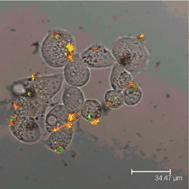Gold nanorod–sphingosine kinase siRNA nanocomplexes: a novel therapeutic tool for potent radiosensitization of head and neck cancer
Abstract
Radiation therapy (RT) is an important treatment modality used against a number of human cancers, including head and neck squamous cell carcinoma (HNSCC). However, most of these cancers have an inherent anti-apoptotic mechanism that makes them resistant to radiation therapy. This radioresistance of cancer cells necessitates the irradiation of tumor areas with extremely high doses of radiation to achieve effective therapy, resulting in damage to normal tissues and leading to several treatment related side effects. These side effects significantly impair the quality of life of treated patients, and preclude the possibility of repeat radiation treatment in patients with tumor recurrence. Our previous research has correlated the upregulation of the anti-apoptotic sphingosine kinase (SphK1) gene in HNSCC cells with their radioresistance properties. In the current study, we hypothesized that by downregulating the SphK1 gene using nanotechnology mediated gene silencing, we can render these cells more vulnerable to radiation therapy by enabling apoptosis at lower radiation doses. We have employed biocompatible gold


 Please wait while we load your content...
Please wait while we load your content...